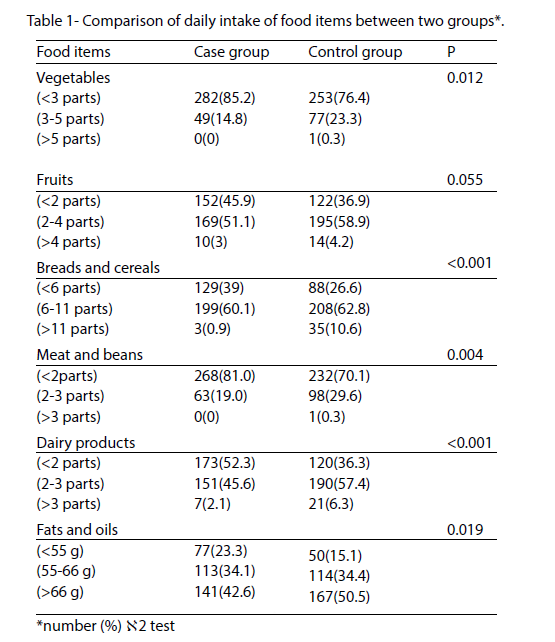Association between nutritional status with spontaneous abortion
Spontaneous abortion is the most common adverse pregnancy outcome occuring in approximately 15% of clinically recognized pregnancies. Although a number of spontaneous abortions are caused by chromosomal abnormalities, maternal factors including nutritional status, also may contribute to this occurrence1-3.
Our aim: study to explore the association between nutrient deficiencies and the risk of spontaneous abortion in humans
This case-control study was carried out in Tehran. The case group (n=331) experienced a spontaneous abortion before 14 weeks of pregnancy, while the control group (n=331) were healthy pregnant women over 14 weeks of pregnancy. Each case was assigned one control matched on maternal age, duration from last delivery in multiparous women, body mass index, occupation, and educational status.
The assessment of dietary intake was performed using the Food Frequency Questionnaire (FFQ) which was previously validated on the adult population of the city of Tehran4 (168 food items consumed in the preceding three months). For assessment of micronutrients intake, Mosbys Nutria Trace Nutrition Analysis Software was used. There were no significant differences between the two groups regarding demographic and obstetric characteristics.
Significant differences on food intake between the two groups
There were significant differences between the number of women in the two groups regarding consumption servings/day of food items (table1).
Our findings indicated that there are significant differences between the two groups in the number of the women who consumed servings/day of food items. Maternal malnutrition is considered to be an important factor contributing to spontaneous abortions by way of altering the germ cell morphology; however, the relationship between maternal nutrition and spontaneous abortion is complex and influenced by several biologic, socioeconomic, and lifestyle factors, which vary extremely in different populations5.
A diet poor in several nutrients may increase risk of spontaneous abortion
There is a significant association between all micronutrients and spontaneous abortion (table 2).
It was recognized that poor pregnancy outcomes, result not only from a deficiency of protein and macronutrient but also from inadequate intake of micronutrients that are vital during pregnancy1-3. A number of studies have indicated that suboptimal vitamin B6 status and elevated plasma total homocysteine concentration are a marker of poor folate or vitamin B12 status, may increase the risk of spontaneous abortion. We also found lower consumption of vitamin C, iron and zinc in the women with spontaneous abortion. This is consistent with other studies, in which they have found an association between poor micronutrients status and adverse pregnancy outcomes1-3.
Our findings illustrated that a diet poor in several nutrients may increase risk of spontaneous abortion.

Based on: Ahmadi R, Ziaei S, Parsay S. Association between nutritional status with spontaneous abortion. Int J Fertil Steril. 2017; 10(4): 337-342
References
- Keen CL,Clegg MS,Hanna LA, LanoueL,Rogers JM,Daston GP,Oteiza P,Uriu-Adams JY. The plausibility of micronutrient deficiencies being a significant contributing factor to the occurrence of pregnancy complications. J Nutr 2003;133:1597S-1605S
- de la Calle M,Usandizaga R,Sancha M,Magdaleno F,Herranz A,Cabrillo E. Homocysteine, folic acid and B-group vitamins in obstetrics and gynecology. Eur J Obstet Gynecol Reprod Biol 2003;(107):125-134.
- Abu-Saad K,Fraser D.Maternal nutrition and birth outcome.Epidemiol Rev 2010;32(1):5-25.
- Mirmiran P, Esfahani FH,Mehrabi Y,Hedayati M,Azizi F. Reliability and relative validity of an FFQ for nutrient in the Tehran lipid and glucose study. Public Health Nutr 2010;13(5):654-662.
- Kramer MS,Seguin L,Lydon J,et al.Socio-economic disparities in pregnancy outcome:why do the poor fare so poorly?paediatr perinat epidemiol 2000;14(3):194-210.
